Lets take a look at some of the favorite perennials of landscapers that are not quite as well known as the ones from Part One.
Since, I have not grown most of these myself, I can’t really go into too many details about their care. Most of them are not natives but several do still provide some wildlife benefits such as pollen for bees and butterflies.
One thing I can say is that they are used a lot in the designs I see. Therefore you can be confident they are low care plants that don’t need pampering.
Here are 12 easy care perennials that you may yet not be growing.
Our 12 easy care perennials start with the Astilbes
Visions in Red Astilbe (Astilbe chinensis ‘Vision in Red’)
For some reason, I have never tried to grow Astilbes. Well, that is not entirely true. When I was at Anderson Japanese Gardens we did plant several Astible (not Visions) around the Guest house with a bunch of Christmas ferns. I remember planting them, but never remember seeing them flower.
Now I see them ALL the time specified in landscape plans. Where maximum blooms are wanted in a shady spot, this is the plant I see designers go to time and time again. And trust me these are blooms you WILL notice unlike the ones I planted at the garden.


- Zones: 4 to 8
- Height: 1.5 to 2 feet
- Spread: 1 to 1.5 feet
- Bloom Time: June to July
- Sun: Part shade to full shade
- Water: Medium
- Tolerate: Rabbit, Deer, Heavy Shade, Black Walnut
Obsidian Coral Bells (Heuchera ‘Obsidian’)
We all know flowers aren’t everything in a landscape right. Flowers are usually not that long lasting, whereas plant foliage is there all growing season.
Hosta are still the king of the foliage plant world, but the Coralbells are closing in. None perhaps more then this and the next one.


- Zone: 4 to 9
- Height: 1 to 2 feet
- Spread: 0.75 to 1.5 feet
- Bloom Time: June to July
- Bloom Description: Creamy white
- Sun: Full sun to part shade
- Water: Medium
Palace Purple Coral Bells (Heuchera micrantha var. diversifolia ‘Palace Purple’)
So whats the difference between these two purple leaf coral bells? Palace Purple’ was chosen as the 1991 perennial plant of the year by the Perennial Plant Association.
Does that make it a better plant? Some people have reported this one is a stronger long term grower compared to Obsidian, which may be the better looking of the two if you ask me.
Pick one and if it works for you stick to it and get more, if not, try the other.


- Zone: 4 to 9
- Height: 1 to 2 feet
- Spread: 1 to 1.5 feet
- Bloom Time: June to July
- Bloom Description: Blush white
- Sun: Full sun to part shade
- Water: Medium
Tiny Rubies Dianthus (Dianthus gratianopolitanus ‘Tiny Rubies’)
I never heard of this plant till this year. Shame on me.
This low growing demander of well drained soils is a great flowering perennial that can be used in a mixed groundcover planting.


- Zone: 3 to 9
- Height: 0.5 to 1 feet
- Spread: 1 to 2 feet
- Bloom Time: May to July
- Bloom Description: Rose pink
- Sun: Full sun
- Water: Medium
- Tolerate: Deer
Firewitch Dianthus (Dianthus ‘Feuerhexe’ )
Blooms in Spring with some intermittent repeat bloom in summer. Fragrant flowers. Like all Dianthus, requires well drained soil and prefers it a little alkaline.
Where you want a little pop of Spring color, oh my! this one looks hard to beat.


- Zone: 3 to 8
- Height: 0.25 to 0.5 feet
- Spread: 0.5 to 1 feet
- Bloom Time: May to June
- Bloom Description: Bright magenta
- Sun: Full sun
- Water: Medium
- Tolerate: Deer
Rozanne Geranium (Geranium ‘Gerwat’ )
This hybrid is probably the most acclaimed geranium and for good reason. This heat resistant, almost non stop bloomer represents what plant breeders are looking for in a perennial cultivar.
A clear winner for lots of reasons. You won’t have a full flush of flowers all summer, but they will keep flowering until Autumn. Just buy some and give them a try.




- Zone: 5 to 8
- Height: 1 to 1.5 feet
- Spread: 1 to 2 feet
- Bloom Time: May to July
- Bloom Description: Violet blue with white centers
- Sun: Full sun to part shade
- Water: Medium
- Attracts: Butterflies
- Tolerate: Rabbit, Deer
Max Frei Gernanium (Geranium sanguineum ‘Max Frei’)
All right. This is it. The most used of the perennials were talking about here today, that I see in landscape designs.
It seems everybody can find a place for this low growing plant at the front of a bed.


- Zone: 3 to 8
- Height: 0.5 to 0.75 feet
- Spread: 0.75 to 2 feet
- Bloom Time: May to June
- Bloom Description: Reddish-purple
- Sun: Full sun to part shade
- Water: Medium
- Attracts: Butterflies
- Tolerate: Rabbit, Deer, Clay Soil
Biokovo Cranesbill (Geranium × cantabrigiense ‘Biokovo’)
‘Biokovo’ is the 2015 Perennial plant of the year, so it should gain more usage as more people become aware of it’s positive traits. These include Spring pinkish-white flowers that give way to foliage that turns a beautiful reddish orange in the Fall.


- Zone: 5 to 8
- Height: 0.5 to 1 feet
- Spread: 0.5 to 1 feet
- Bloom Time: May to June
- Bloom Description: White tinged with pink and pink stamens
- Sun: Full sun to part shade
- Water: Medium
- Attracts: Butterflies
- Tolerate: Rabbit, Deer
Royal Candles Speedwell (Veronica spicata ‘Glory’)
Probably the showiest of the Speedwells, it is a standout bloomer. It’s flowers colors the garden for a long period of time from late spring into mid-summer with deep blue blooms.


- Zone: 3 to 8
- Height: 0.75 to 1 feet
- Spread: 0.5 to 0.75 feet
- Bloom Time: June to August
- Bloom Description: Deep blue-purple
- Sun: Full sun
- Water: Medium
- Tolerate: Rabbit, Deer
Walkers Low Catmint (Nepeta racemosa ‘Walker’s Low’ )
Just because this is named Walkers Low, does not mean there is anything low about it. ‘Walker’s Low’ easily gets to 2-3 feet tall with a similar spread. It’s name comes from the garden it was discovered in.
Bees and butterflies are suppose to love the small flowers. The leaves have a distinctive minty smell that may be why rabbits and deer don’t bother it much.
As with other catmints ‘Walker’s Low’ has few insect or disease issues and requires little maintenance. Walkers Low was also a Perennial Plant of the Year winner for the year 2007.


- Zone: 4 to 8
- Height: 2 to 2.5 feet
- Spread: 2.5 to 3 feet
- Bloom Time: April to September
- Bloom Description: Lavender blue
- Sun: Full sun to part shade
- Water: Dry to medium
- Tolerate: Deer, Drought, Dry Soil
Patriot Hosta (Hosta ‘Patriot’)
I couldn’t finish this post without talking about at least one hosta. There are others that I like better, like Frances William, but if you want a variegated green and white Hosta in your landscape or garden, check out this guy. This is the go to Hosta for several of the Landscape designers and architects I know.
And why not?
Gorgeous foliage, nice grower, beautiful form. It’s also sun tolerant and pretty slug-resistant. Some people like ‘Minuteman’ which is similar, better.


- Zone: 3 to 8
- Height: 1 to 1.5 feet
- Spread: 2 to 2.5 feet
- Bloom Time: July to August
- Bloom Description: Lavender
- Sun: Part shade to full shade
- Water: Medium
- Tolerate: Heavy Shade, Black Walnut
Kobold Liatris (Liatris spicata ‘Kobold’)
This selection of the native US wildflower attracts butterflies and bumblebees in mass during it’s relatively long bloom period. Seems like a middle of the border plant with it’s spikey flowers.
If you have enough sun for it, give a small grouping of 3 or 5 of these in the middle of a perennial bed, prairie or meadow a try.

- Zone: 3 to 8
- Height: 1.5 to 2.5 feet
- Spread: 0.5 to 1 feet
- Bloom Time: July to August
- Bloom Description: Deep purple
- Sun: Full sun
- Water: Medium
- Attracts: Birds, Hummingbirds, Butterflies
- Tolerate: Clay, Drought
Hopefully, you found at least one low maintenance, strong growing perennial you can add to your garden today. Next time we will begin a new landscape design for….?
Julie zinderman says
Jim I love it when you send out an email.I hope your new job is going well. I have 5 crabapples that were getting out of control. I followed your 4 step demo last winter and this year they look fab. Thanks so much for dedicating your time to us consumers.